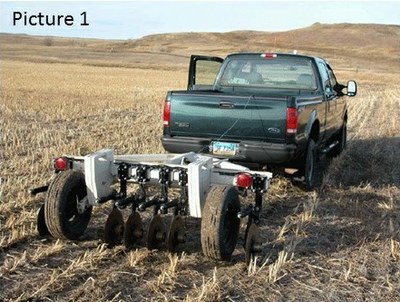Perennial Grasses for Saline Areas
 Roughly six million acres in North Dakota are considered saline soils. That’s approximately 13% of the acres in North Dakota or an area about the size of Vermont. The most common way to measure soil salinity is by measuring soil electrical conductivity (EC). For soil to be considered saline, it must have an EC of four or higher. Crops like dry bean, soybean, and corn are affected at EC’s lower than four. Once EC’s get above six most crops are being affected by soil salinity, which affects profitability. Ongoing demonstration plots were established near Carrington and Buchanan in 2010 to determine the most appropriate perennial grass species for various soil salinity levels. Species were selected based on ease of establishment for forage production. A Veris machine (Picture 1) was used to map sites for EC. Sites were ground truthed to determine the field gradient. This information was used to orient plots across the salinity gradient before plots were seeded in 2010. Plots with adequate stands were harvested for hay production and EC readings were taken again after harvest.
Roughly six million acres in North Dakota are considered saline soils. That’s approximately 13% of the acres in North Dakota or an area about the size of Vermont. The most common way to measure soil salinity is by measuring soil electrical conductivity (EC). For soil to be considered saline, it must have an EC of four or higher. Crops like dry bean, soybean, and corn are affected at EC’s lower than four. Once EC’s get above six most crops are being affected by soil salinity, which affects profitability. Ongoing demonstration plots were established near Carrington and Buchanan in 2010 to determine the most appropriate perennial grass species for various soil salinity levels. Species were selected based on ease of establishment for forage production. A Veris machine (Picture 1) was used to map sites for EC. Sites were ground truthed to determine the field gradient. This information was used to orient plots across the salinity gradient before plots were seeded in 2010. Plots with adequate stands were harvested for hay production and EC readings were taken again after harvest.
Smooth Bromegrass was the check because it is growing in the majority of ditches in North Dakota so most people are familiar with what it looks like. Meadow bromegrass is a high quality forage species used in hay production and Creeping Foxtail grows well in wet areas which these saline areas tend to be. These species perform fairly well until an EC of 6.5-7.0 and then the stand and production drops off rapidly.
Switchgrass was used because of its promotion as a potential biofuels crop at the time of planting. As you can see, it produces high yields of lower quality forage but not in saline soils. Canada wildrye is an early season grass that produces a reasonable amount of forage up to an EC of about 7. Multistem wildrye produces nice yields of high quality forage up to an EC of about 10.
The Tall, Slender, and Western wheatgrasses have been widely and historically recommended for these saline areas based on their ease of establishment and their yields on EC’s in the 10-12 range. Slender and Western wheatgrass produce adequate quality forage but the stands decreased this past season. Tall wheatgrass is a tremendous yielder of low quality forage up to an EC of about 12. However, it may provide a lot of cover for potential wildlife habitat.
These last three are relatively new variety releases. They provide very stable yields of high quality forage up to EC’s of 10 -14. These along with Tall wheatgrass continue to be very thick stands with no sign of stand loss.
Conclusions:
EC readings changed over time at each location in this trial with a possible downward trend under the more saline tolerant grass species. The wheatgrasses and multistem wildrye continue to provide stable yields across the salinity gradient. This study will continue to track salinity, stand and forage production over another season to develop recommendations for the most appropriate species based on EC values and targeted end-use for landowners and farmers.
Ezra Aberle
Agronomy Research Specialist


